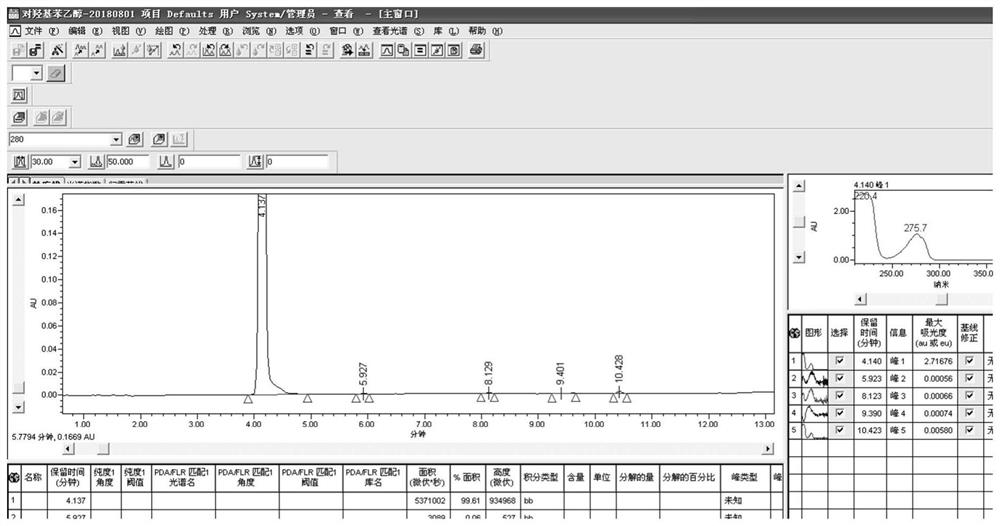A kind of synthetic method of p-hydroxyphenethyl alcohol
A technology for p-hydroxyphenethyl alcohol and a synthesis method, which is applied in the field of synthesis of p-hydroxyphenethyl alcohol, can solve the problems of high raw material cost, strict requirements on production equipment and raw materials, complicated processes, etc., and achieves simple and mild reaction conditions, low cost, and high efficiency. Handling simple effects
- Summary
- Abstract
- Description
- Claims
- Application Information
AI Technical Summary
Problems solved by technology
Method used
Image
Examples
preparation example Construction
[0032] A kind of synthetic method of p-hydroxyphenethyl alcohol, comprises the following steps:
[0033] 1) Add methanol, sodium methoxide and a catalyst into the reactor and stir; the catalyst is selected from potassium iodide and cuprous iodide; the amount of the catalyst is 0.05-0.1 times the mass of 4-chlorophenethyl alcohol.
[0034] 2) 4-chlorophenethyl alcohol is added into the above-mentioned reactor in batches, and the temperature is raised to the reflux temperature for reaction; the consumption of methanol is 3-6 times of the quality of 4-chlorophenethyl alcohol. The molar ratio of sodium methoxide and 4-chlorophenethyl alcohol is 5-10:1.
[0035] 3) The solution obtained after the reaction in step 2) is lowered to room temperature, filtered, and the filtrate is evaporated to dryness to obtain a crude 4-methoxyphenethyl alcohol;
[0036] 4) adding the crude 4-methoxyphenethyl alcohol obtained in step 3) into another reactor, adding a solvent, and stirring; the solve...
Embodiment 1
[0041] 1) Add 15kg of methanol, 5.4kg of sodium methoxide and 0.23kg of CuI to the reactor at room temperature to start stirring.
[0042] 2) 3.13 kg of 4-chlorophenethyl alcohol was added to the above mixed solution in batches, and heated to about 80 degrees to reflux.
[0043] 3) The material was cooled to room temperature, filtered, and the filtrate was spin-dried to obtain crude 4-methoxyphenethyl alcohol: 3kg.
[0044] 4) Add the obtained material into the reaction kettle, add 15kg of glacial acetic acid, and stir at room temperature.
[0045] 5) wherein drip 47% hydrobromic acid 10.3kg, be warming up to 116 ℃, be incubated and refluxed.
[0046] 6) Sampling detection, 4-methoxyphenethyl alcohol reaction is completed, and it is cooled to about 60 DEG C. Slowly add 20% sodium carbonate solution dropwise to the material while observing the pH value of the reaction. When the pH value is between 6-7, stop dripping.
[0047] 7) Continue the insulation reaction for 2h, be c...
Embodiment 2
[0050] 1) Add 15kg of methanol, 8.6kg of sodium methoxide and 0.27kg of KI to the reactor at normal temperature to start stirring.
[0051] 2) 3.13 kg of 4-chlorophenethyl alcohol was added to the above mixed solution in batches, heated to about 84 degrees and refluxed.
[0052] 3) The material was cooled to room temperature, filtered, and the filtrate was spin-dried to obtain crude 4-methoxyphenethyl alcohol: 2.96 kg.
[0053] 4) Add the obtained material into the reaction kettle, add 17.7kg of glacial acetic acid, and stir at room temperature.
[0054] 5) wherein drip 12.1kg of 40% hydrobromic acid, be warming up to 116 ℃, be incubated and refluxed.
[0055] 6) Sampling detection, 4-methoxyphenethyl alcohol reaction is completed, and it is cooled to about 60 DEG C. Slowly add 10% sodium hydroxide solution dropwise to the material while observing the pH value of the reaction. When the pH value is between 6-7, stop dripping.
[0056]7) Continue the insulation reaction for ...
PUM
 Login to View More
Login to View More Abstract
Description
Claims
Application Information
 Login to View More
Login to View More - R&D
- Intellectual Property
- Life Sciences
- Materials
- Tech Scout
- Unparalleled Data Quality
- Higher Quality Content
- 60% Fewer Hallucinations
Browse by: Latest US Patents, China's latest patents, Technical Efficacy Thesaurus, Application Domain, Technology Topic, Popular Technical Reports.
© 2025 PatSnap. All rights reserved.Legal|Privacy policy|Modern Slavery Act Transparency Statement|Sitemap|About US| Contact US: help@patsnap.com

